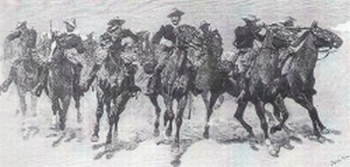Captain Dodge's Colored Troops to the Rescue

Frederick Remington Print "Captain Dodge's Colored Troops to the Rescue
In 1879 tensions between Whites and Ute Native Americans reached the point prompting the White River Agency Indian Agent, Mr. Nathan C. Meeker to request the U.S. Army. The Utes occupied and claimed 3/4 of Colorado and a large swath of Utah as their land.
Major Thomas T. Thornburgh set out from Fort Steele on September 21, 1879 with Company E, 3rd Cavalry, D and F Companies, 5th Cavalry and Company B from his own 4th Infantry Regiment. Included in the column as it left Rawlins, Wyoming, were thirty-three supply wagons and 200 pack mules. For the next 7 days, with about 200 men, Major Thornburgh marched toward the agency, reporting his progress to General George Crook.
The advance guard of the formation, under the command of Lieutenant S.A. Cherry, crossed the Milk River and took up a position approximately 1/2 mile from the main body. Major Thornburgh, concerned about ambush, proceeded cautiously. Lt. Cherry came upon 300-400 Utes and turned and road "hell-bent for Thornburgh." The Utes, anticipating a cavalry charge deployed their forces. Soon gunfire erutped on both flanks of the main body and the Utes attempted to envelope Thornburgh's main body. The volume of fire by the Utes was heavy as Thornburgh executed a slow dismounted withdrawal back towards the relative safety of the north side of the river and the supply wagons with the infantry company. As the command was withdrawing, Major Thornburgh was killed.
Captain J. Scott Payne of the 5th Cavalry took command. The main body reached the supply wagons as a "wild orgy of violence" ensued. On the night of September 29, the beseiged troops fought off an attempt to overwhelm their defenses and the situation remained desperate. All the horses and mules were killed by the tremendous Ute gunfire which also prevented the soldiers from reaching the river for badly needed water.
One of the Native Americans taking part in this battle and the only Indian punished, was Captain Jack, a Modoc subchief played by actor Charles Bronson in the 1954 motion picture, "Captain Jack."
Captain Payne sent out four volunteers to go for assistance. On October 1, 1879, one courier met Company D, 9th Cavalry, which was en route to the agency. Captain Francis Dodge rode with his company toward the beseiged command and sent out messages reporting the situation.
Meanwhile the Utes taunted the soldiers "Come out, you sons-of-bitches, and fight like men-Utes kill 'orr 'orse and mool and kill oo."
On the morning of October 2, 1879, the spirits of Captain Payne's troops were raised by the arrival of D Company, 9th Cavalry. Although D Company arrived undetected by the Utes, the Buffalo Soldiers rode the last 600 yards under the guantlet of heavy fire. D Company settled in and defended against the Utes awaiting further reinforcements.
Around noon the 5th of October, the beseiged troops heard the sound of a bugle blaring "officer's call." Colonel Wesley Merritt, 5th Cavalry arrived with 500 men. Also converging on the defensive breastworks were Colonel Ronald S. Mackenzie with six companies of the 4th Cavalry from Fort Clark, Texas and Colonel Hatch of the 9th Cavalry with five additional companies. Colonel Merritt's combined force swelled to over 1,500 men.
The above matters are covered in greater detail in a scholarly study by Major Russel D. Santala of the Army's Combined Arms Research Library.
Return to Home Page

